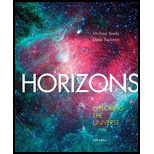
Phobos obits Mars at a distance of 9376 km from the center of the planet and has a period of 0.3 189 days. Assume Phobos’s orbit is circular. Calculate the mass of Mars. (Hints: Use the circular orbit velocity formula in Reasoning with Numbers 4-1; make sure to convert relevant quantities to units of meters, kilograms. and seconds.)
To calculate:
The mass of Mars based on the distance and orbit angle of Phobos
Answer to Problem 5P
The mass of Mars =
Explanation of Solution
Given Information:
Radius of orbit = 9376 Km
Period of Orbit = 0.3189 Days
Formula Used:
Circular orbit velocity =
Also, VS=distance/time
Calculation:
Assume Phobos (Moons) orbit to be circular.
First convert the quantities into proper units
Now,
Circular Velocity =
Where, G = Gravitational Constant =
r = Radius of Planet. (m)
m= Mass of Planet (Kg)
Rewriting in terms of m
∴ m =
For finding circular velocity that is distance covered per unit time.
∴ VS =Distance/time
Distance between but circumference of orbit.
∴
∴ Moon must cover 5.9 x 107 m distance in 27552.96 sec
∴ its circular velocity must be,
∴ put all the Values in mass of Mars formula,
=
=
Conclusion:
Mass of Mars is
Want to see more full solutions like this?
Chapter 17 Solutions
Horizons: Exploring the Universe (MindTap Course List)
Additional Science Textbook Solutions
Physics for Scientists and Engineers: A Strategic Approach, Vol. 1 (Chs 1-21) (4th Edition)
Mathematical Methods in the Physical Sciences
The Physical Universe
University Physics Volume 2
Physics for Scientists and Engineers: A Strategic Approach with Modern Physics (4th Edition)
- Does Marss surface experience any meteorite impacts today? How do you know?arrow_forwardWhat is the maximum angular diameter of the dwarf planet Ceres when it is closest to Earth? Could Earth-based telescopes detect surface features? Could the Hubble Space Telescope? (Hint: Use the small-angle formula, Eq. 3-1.) (Notes: Ceress average distance from the Sun is 2.8 AU and its diameter is 950 km. The best angular resolution of Earth-based telescopes at visual wavelengths is about 1 arc second and of Hubble about 0.1 arc second.)arrow_forwardWould you expect as many impact craters per unit area on the surface of Venus as on the surface of Mars? Why or why not?arrow_forward
- What is the orbital velocity and period of a ring particle at the outer edge of Saturns A ring? (Hint: Use the formula for circular velocity, Eq. 5-1a. The formula requires input quantities in kg and m.) (Note: The radius of the outer edge of the A ring is 136,500 km.)arrow_forwardA Sense of Proportion: Mercury averages only 0.39 AU from the Sun, Venus 0.72 AU and Mars 1.52 AU. If you built a model solar system and represent the average distance from the Sun to Earth as 10 inches, how far would you place Mercury, Venus and Mars from the Sun?arrow_forwardWhich of the following is NOT best explained by Venus's extreme greenhouse effect? a. its extremely high surface temperature b. its extremely uniform surface temperature c. its extremely low surface wind speeds d. its lack of magnetismarrow_forward
 Horizons: Exploring the Universe (MindTap Course ...PhysicsISBN:9781305960961Author:Michael A. Seeds, Dana BackmanPublisher:Cengage Learning
Horizons: Exploring the Universe (MindTap Course ...PhysicsISBN:9781305960961Author:Michael A. Seeds, Dana BackmanPublisher:Cengage Learning Foundations of Astronomy (MindTap Course List)PhysicsISBN:9781337399920Author:Michael A. Seeds, Dana BackmanPublisher:Cengage Learning
Foundations of Astronomy (MindTap Course List)PhysicsISBN:9781337399920Author:Michael A. Seeds, Dana BackmanPublisher:Cengage Learning

 AstronomyPhysicsISBN:9781938168284Author:Andrew Fraknoi; David Morrison; Sidney C. WolffPublisher:OpenStax
AstronomyPhysicsISBN:9781938168284Author:Andrew Fraknoi; David Morrison; Sidney C. WolffPublisher:OpenStax




